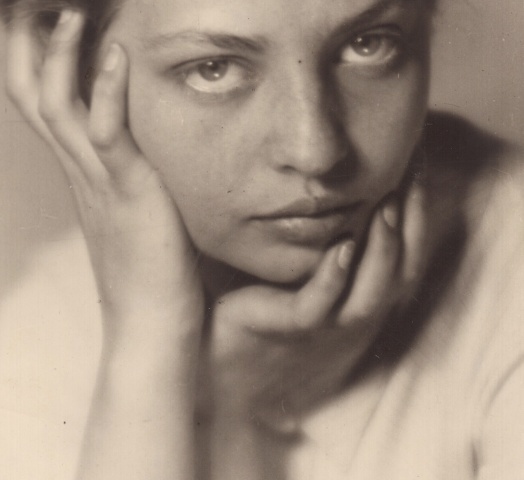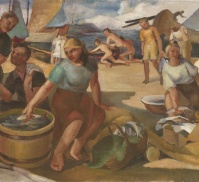The Vilniusite. Sofija Urbonavičiūtė-Subačiuvienė (1915–1980)
The 2015 season of autumn exhibitions in Vilnius Graphic Art Centre Gallery is started by the exposition devoted to the 100th birth anniversary of Sofija Urbonavičiūtė-Subačiuvienė (1915–1980), Vilnius painter and photographer of Lithuanian origin. The public is invited to get retrospectively acquainted with the diverse, although not large, artistic legacy: painting, prints, book and applied graphics, drawings and photographs of the graduate of Steponas Batoras University Art Faculty. Major biographical facts of the artist are illustrated by archival documents.
The sparse legacy of painting and graphic works by Sofija Urbonavičiūtė-Subačiuvienė is little familiar even to art specialists. Works, gathered in one exposition, helps better know the artist’s creative specifics. This exhibition provides an excellent opportunity to see her works kept in private collections and get familiar with the large-format diploma work titled Fishermen of Steponas Batoras University Art Faculty (1938). Beside the prints created during the study years, Vilnius Graphic Art Centre exhibits for the first time books and magazines illustrated by the artist and examples of packages of goods created by her which supplement the scarce knowledge about the late artistic activity of the author during her work at Vilnius plant Dailė and Marytė Melnikaitė sponge-biscuit factory.
While attending classes in the studio of Jan Bulhak (1876–1950), the famous photographer of Vilnius, lecturer of Steponas Batoras University, the future artist got interested in possibilities offered by photography and started to take pictures. The portraits and compositions of artistic nature created in the fourth decade of the 20th century shown in the exhibition are likely to have been taken as practical tasks for the lectures of J. Bulhak. Sofija Urbonavičiūtė-Subačiuvienė became best known as a photographer from the images of Vilnius destroyed during the Second World War she captured in 1944 upon order of the Institution for Protection of Cultural Assets that were found already after her death. This photo collection of Vilnius architecture assets, preserved only by a lucky chance, was introduced to the audience for the first time at the exposition arranged in 1994 in the Lietuvos Aidas gallery. Part of the images of the 1944 Vilnius is also shown in the exhibition The Vilniusite. Sofija Urbonavičiūtė-Subačiuvienė (1915–1980); the early photographs of their author can also be seen here.
Curator Ieva Burbaitė
Coordinators Kristina Kleponytė-Šemeškienė, Jurga Minčinauskienė
Designer Gedas Čiuželis
Organizer Vilnius Graphic Art Centre
Sponsor Lithuanian Council for Culture
The exhibits were borrowed from:
Law firm "Valiunas Ellex", the Lithuanian Art Museum, Lithuanian Artists’ Association, Lithuanian Literature and Art Archive, Martynas Mažvydas National Library of Lithuania, National Museum of Lithuania, Museum of Vilnius Art Academy, Jūratė Burokaitė, Vida Domarkienė and Vidmantas Martikonis.

The 2015 season of autumn exhibitions in Vilnius Graphic Art Centre Gallery is started by the exposition devoted to the 100th birth anniversary of Sofija Urbonavičiūtė-Subačiuvienė (1915–1980), Vilnius painter and photographer of Lithuanian origin. The public is invited to get retrospectively acquainted with the diverse, although not large, artistic legacy: painting, prints, book and applied graphics, drawings and photographs of the graduate of Steponas Batoras University Art Faculty. Major biographical facts of the artist are illustrated by archival documents.
The sparse legacy of painting and graphic works by Sofija Urbonavičiūtė-Subačiuvienė is little familiar even to art specialists. Works, gathered in one exposition, helps better know the artist’s creative specifics. This exhibition provides an excellent opportunity to see her works kept in private collections and get familiar with the large-format diploma work titled Fishermen of Steponas Batoras University Art Faculty (1938). Beside the prints created during the study years, Vilnius Graphic Art Centre exhibits for the first time books and magazines illustrated by the artist and examples of packages of goods created by her which supplement the scarce knowledge about the late artistic activity of the author during her work at Vilnius plant Dailė and Marytė Melnikaitė sponge-biscuit factory.
While attending classes in the studio of Jan Bulhak (1876–1950), the famous photographer of Vilnius, lecturer of Steponas Batoras University, the future artist got interested in possibilities offered by photography and started to take pictures. The portraits and compositions of artistic nature created in the fourth decade of the 20th century shown in the exhibition are likely to have been taken as practical tasks for the lectures of J. Bulhak. Sofija Urbonavičiūtė-Subačiuvienė became best known as a photographer from the images of Vilnius destroyed during the Second World War she captured in 1944 upon order of the Institution for Protection of Cultural Assets that were found already after her death. This photo collection of Vilnius architecture assets, preserved only by a lucky chance, was introduced to the audience for the first time at the exposition arranged in 1994 in the Lietuvos Aidas gallery. Part of the images of the 1944 Vilnius is also shown in the exhibition The Vilniusite. Sofija Urbonavičiūtė-Subačiuvienė (1915–1980); the early photographs of their author can also be seen here.
Curator Ieva Burbaitė
Coordinators Kristina Kleponytė-Šemeškienė, Jurga Minčinauskienė
Designer Gedas Čiuželis
Organizer Vilnius Graphic Art Centre
Sponsor Lithuanian Council for Culture
The exhibits were borrowed from:
Law firm "Valiunas Ellex", the Lithuanian Art Museum, Lithuanian Artists’ Association, Lithuanian Literature and Art Archive, Martynas Mažvydas National Library of Lithuania, National Museum of Lithuania, Museum of Vilnius Art Academy, Jūratė Burokaitė, Vida Domarkienė and Vidmantas Martikonis.







